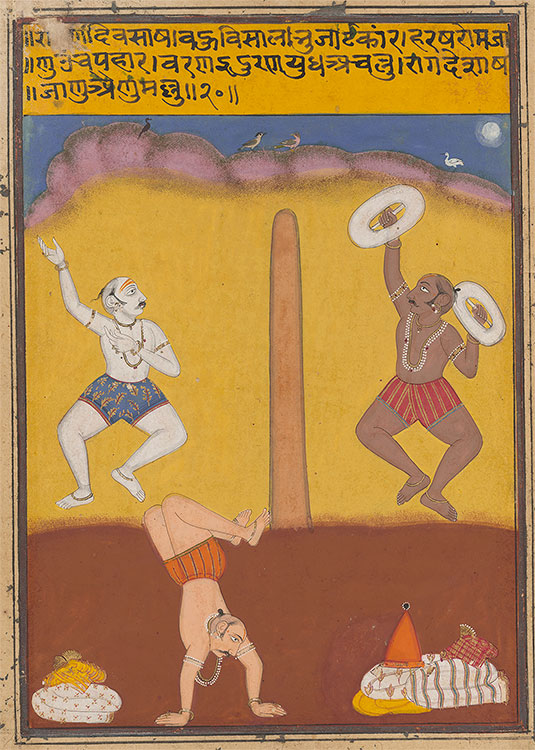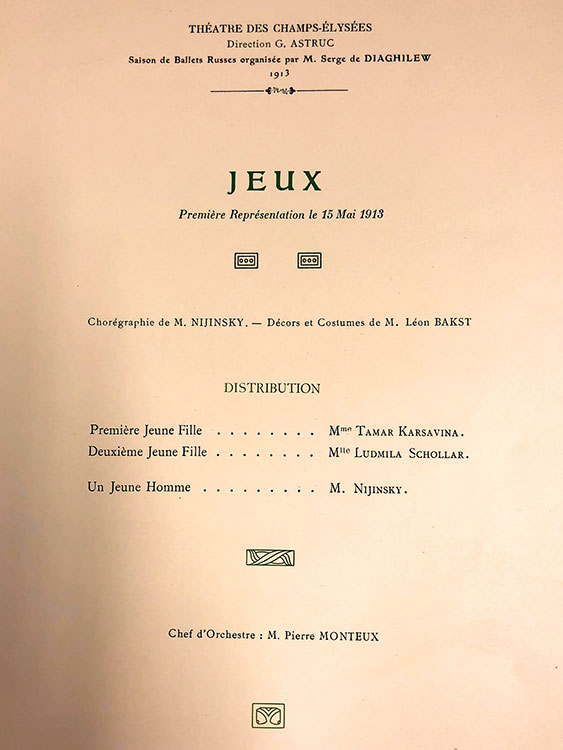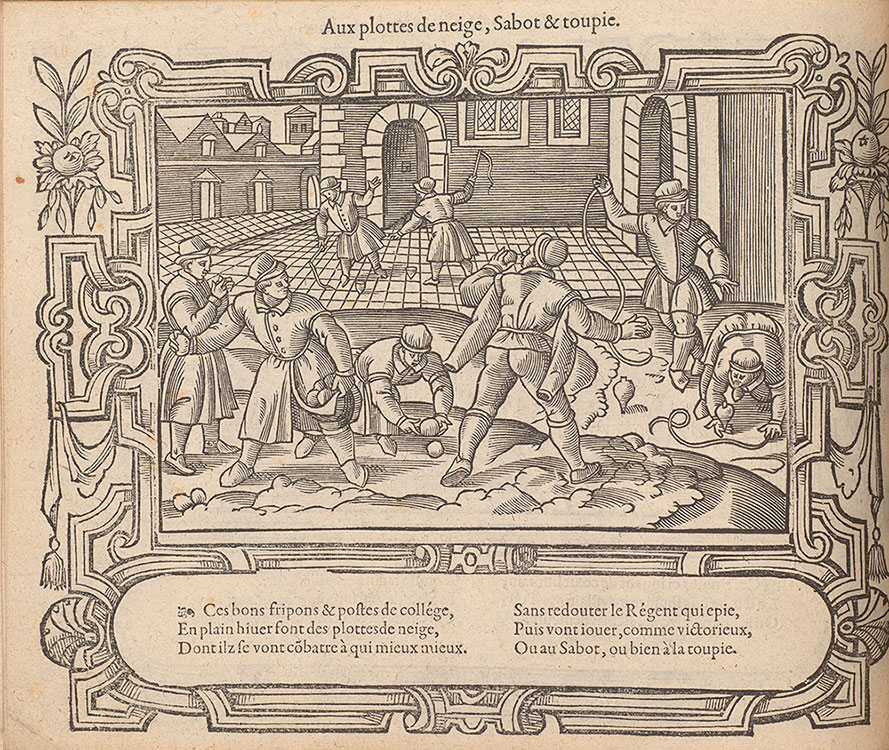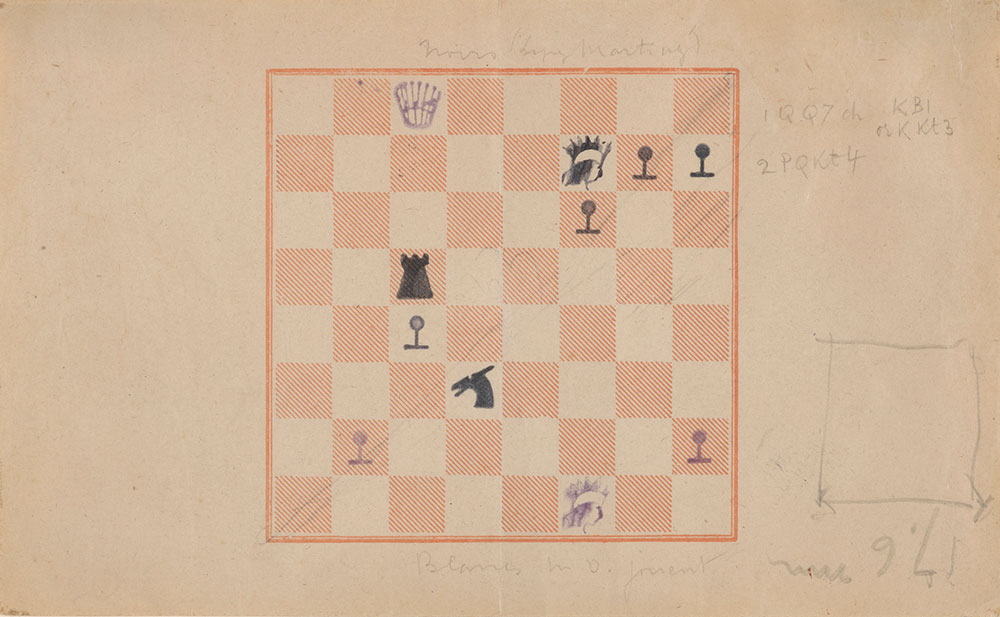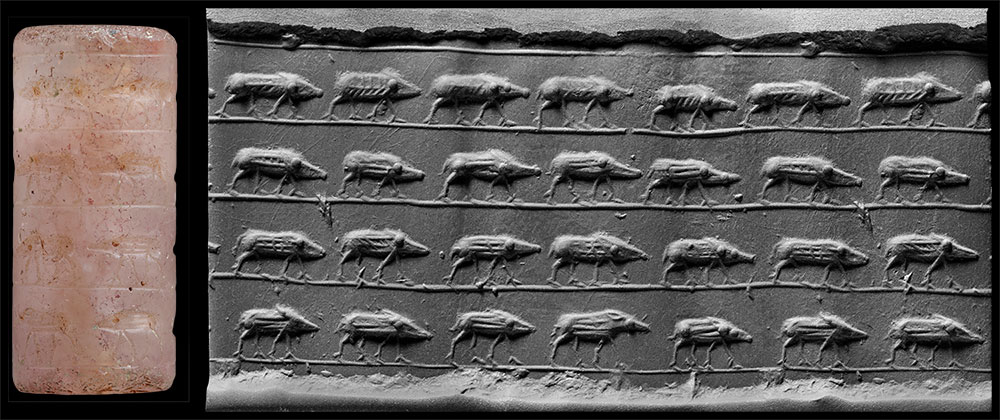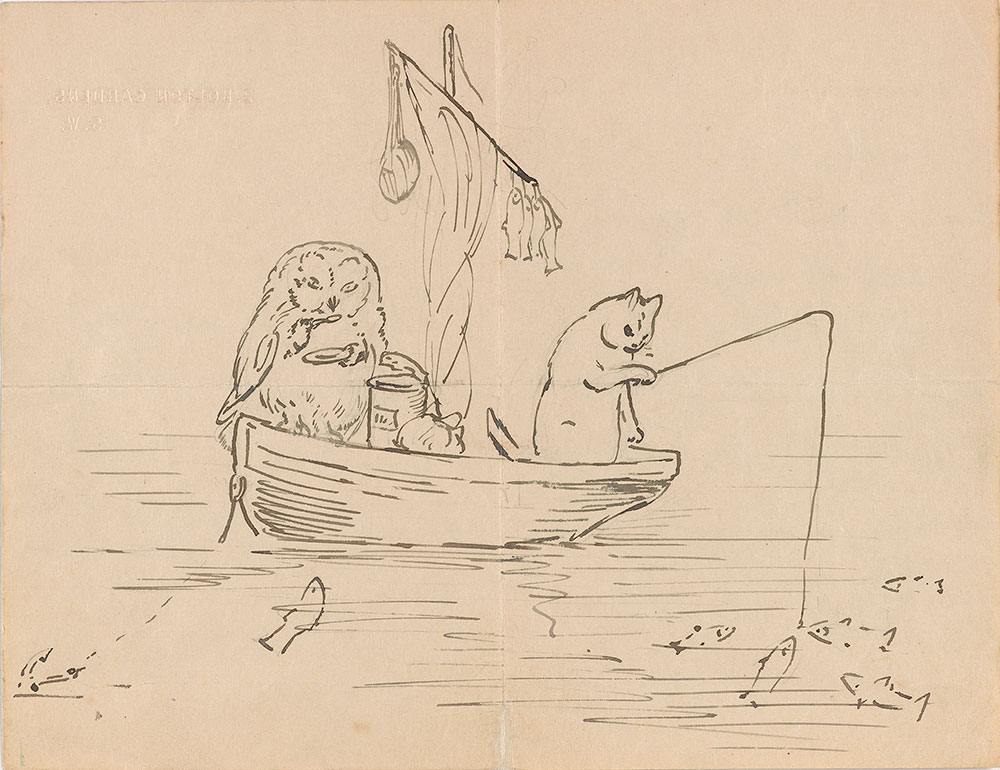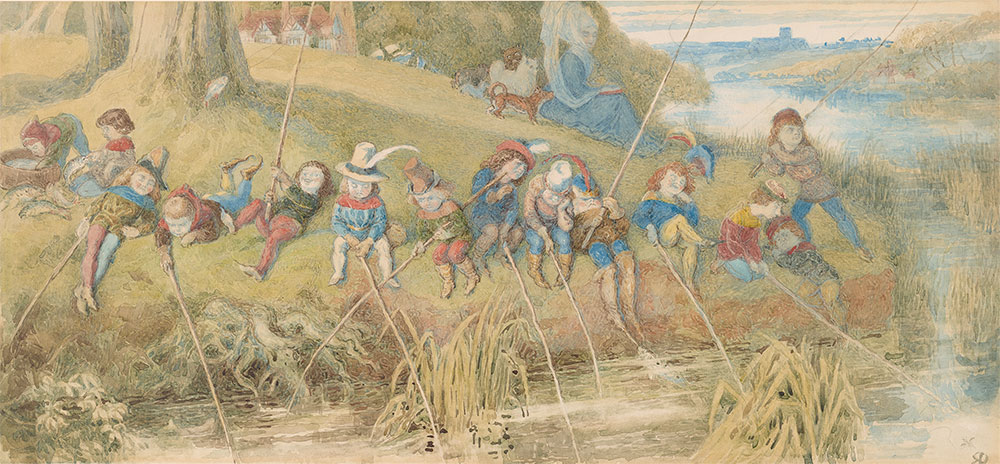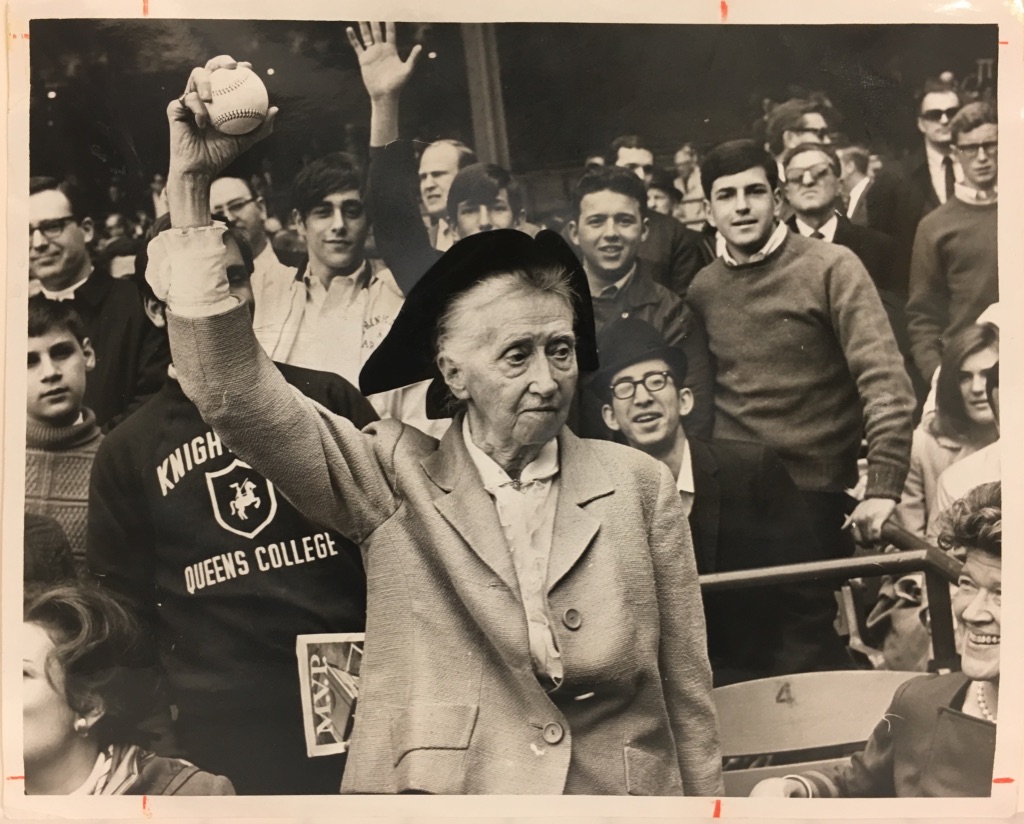Morganmobile: Sports and Games
Purvis Young, a genius of the art of “making do,” drew and painted on repurposed sheets of paper that he pasted over the pages of found books. This volume features dozens of drawings of men playing basketball and football. The book’s title, Sometimes I Get Emotion from the Game, suggests the value of sport as an escape from the harsh realities of life in Overtown, Miami. In this spread, players partially obscured by spattered paint stretch their arms overhead—a gesture that might be read as one of either striving or surrender.
Spread from Purvis Young (1943–2010), Sometimes I Get Emotion from the Game, early 1980s. Ballpoint pen and marker on paper glued to found book, 12 1/4 x 17 3/4 inches (31.12 x 45.09 cm). Gift of the Souls Grown Deep Foundation from the William S. Arnett Collection and purchase on the Manley Family Fund, 2018.106.
© Purvis Young / Artists Rights Society (ARS), New York.
Morganmobile: Sports and Games
Around a table in a ramshackle Roman courtyard, a group of men are united in a round of the Italian betting game of morra. The two competitors flash a certain number of fingers on their right hands while guessing out loud the total number that will be presented by both players. The intensity of play is reflected in the face of the man at center, closely counting the players’ fingers, while the woman washing a child’s bottom at left reveals the utter indifference of those outside the game.
Jean Baptiste Greuze (1725–1805), The Game of Morra, 1756. Pen and brown ink and wash with gray wash over graphite. Thaw Collection, 2017.109
Morganmobile: Sports and Games
Sport and game meet in hunting, which became a popular aristocratic pastime in the Middle Ages. In the late fourteenth century, the avid sportsman Gaston III Phoebus, count of Foix (1331–91), composed a hunting manual divided into four parts: Gentle and Wild Beasts, Nature and Care of Dogs, Hunting with Dogs, and Hunting with Traps, Snares, and Crossbow. The Morgan’s copy, one of the most magnificent such manuals in the world, is lavishly illustrated with eighty-seven large paintings. The manuscript was made for Louis I, duke of Orléans and brother of King Charles VI of France.
“Deer Hunting” from Gaston III Phoebus, Livre de la chasse (Book of the Hunt), in French and Latin, France, Paris, ca. 1406. Illuminated for Louis d’Orléans possibly by the Bedford Master, MS M.1044, fol. 76 (det.), Bequest of Clara S. Peck, 1983.
Morganmobile: Sports and Games
Baseball, or Base-Ball, appears for the first time in a book printed in America in A Little Pretty Pocket-Book in 1787. The text, being “Intended for the Instruction and Amusement of Little Master Tommy, and Pretty Miss Polly,” compares running the bases with a boy’s “flying away” in search of fame and fortune, hoping to return safely “Home.” Baseball would not become known as a national pastime until it was played professionally by adults in the mid-nineteenth century.
A Little Pretty Pocket-Book, Intended for the Instruction and Amusement of Little Master Tommy, and Pretty Miss Polly. The first Worcester edition. Worcester, Mass.: Isaiah Thomas, 1787. PML 88064. Gift of Julia P. Wightman, 1991.
Morganmobile: Sports and Games
The Pythian Games, one of the four ancient Panhellenic competitions, were held every four years in the city of Delphi. Dedicated to the sun god Apollo, whose round temple is visible in the distance, the tournament combined athletic games with contests of art and dance. The quadrennial event becomes a setting for romance in Abraham Bloemaert’s drawing, which portrays an episode from the ancient Greek novel Aethiopica (The Ethiopian Story). The lance-wielding noble Theagenes, who has traveled to Delphi to compete, will soon fall in love with the priestess Chariclea, riding in an ox-drawn carriage at right.
Abraham Bloemaert (1564–1651), Theagenes and Chariclea at the Pythian Games at Delphi, ca. 1625–1628. Black chalk and pale brown wash, with white opaque watercolor. Purchased as the gift of the Fellows, 1961.26
Morganmobile: Sports and Games
Having removed and folded their colorful outer garments, three athletes demonstrate their physical prowess in this Indian miniature. While the agile man in the foreground executes a handstand, the muscular pair flanking a pole used for climbing leap into the air. Originally, the miniature would have been part of a series illustrating different musical modes. The inscription equates the energetic mode of Desakh with a tall, fierce, long-armed wrestler who slaps his body resoundingly and is resplendent like the moon.
Desakha Ragini, from a Ragamala series, Rajasthan, India, ca. 1725, MS M.1049.1, Gift of Anna C. Walter, 1983.
Morganmobile: Sports and Games
Dancer and choreographer Vaslav Nijinsky created the scenario for Jeux (Games) with artist Léon Bakst for Sergei Diaghilev's Ballets Russes after witnessing an evening tennis game in a private garden. Two girls and a boy, searching for their lost tennis ball, are bewitched by the warm evening air, but their flirtatious games are interrupted when another ball lands nearby. Jeux, in its turn, was upstaged by the riotous debut of Stravinsky's Sacre du Printemps two weeks later. This first-edition score names the performers who presented the 1913 premiere. Debussy's autograph manuscript score is also at the Morgan, in the Robert Owen Lehman collection on deposit.
Claude Debussy (1862–1918), Jeux, Paris: Durand, ca. 1912 (1913?) printing. Mary Flagler Cary Music Collection.
Morganmobile: Sports and Games
Amid violent religious conflicts and assassinations under the rule of Henry III, Nicholas Prévost published what is likely the first European illustrated book devoted to children’s amusements. The Morgan owns the only complete copy. Comprising thirty-six prints by an unidentified artist, the album depicts more than one hundred ludic pastimes from the cradle to late adolescence. Games played with nuts, hats, balloons made from pig bladders, and even insects are featured, along with tennis, seesaws, archery, and hoops. Winter entertainments, shown here, include a snowball fight at close range and, for the less combative, spinning tops.
Les Trente six figvres, contenant tous le ieux qui se peurent jamais inventer et representer par les enfans tant garsons que filles (Thirty-six Figures, Containing All the Games that Could Ever Be Invented and Played by Children, Both Boys and Girls), (Paris: Nicolas Prévost, 1589). Purchased on the Fellows Fund, with the special assistance of Julia P. Wightman, 1975–1977. PML 83633
Morganmobile: Sports and Games
An avid chess player, Marcel Duchamp had a set of rubber stamps made with which to record games and play by mail. Just as he conceived of art as a mental activity, he was attracted to the aesthetic dimension of chess: “Objectively a game of chess looks very much like a pen-and-ink drawing, with the difference, however, that the chess player paints with black and white forms already prepared instead of inventing forms as does the artist.” Imagination and invention are required for both pursuits, Duchamp notes, but he adds: “while all artists are not chess players, all chess players are artists.”
Marcel Duchamp (1887–1968), Chessboard Configuration, 1919. Chessboard printed in orange ink, with rubber stamps of chess pieces printed in black and purple inks, and graphite, on off-white paper, 4 3/16 x 6 13/16 inches (11.4 x 17.5 cm). Gift of Salle Vaughn in honor of Charles Ryskamp on the occasion of the seventy-fifth anniversary of the Morgan Library and the fiftieth anniversary of the Association of Fellows, 2000.16.
© Marcel Duchamp / Artists Rights Society (ARS), New York
Morganmobile: Sports and Games
The iconography of Persian royal power included orderly processions of wild animals, such as boars and lions, which the king enjoyed the privilege of hunting. The beasts would be corralled into an enclosed area for the king to show off his hunting skill. As the great palace reliefs depict people of the empire paying homage to the leader—alluding to his control of the political realm—the boars carved on this seal imply his dominion over nature. To a modern eye, the design of the seal evokes the pioneering chronophotographs of Edweard Muybridge (1830–1904).
Ancient cylinder seal with modern impression: Four Rows of Striding Boars. Persia, Achaemenid period, (ca. 550–330 B.C.). Rock crystal, 1 3/16 × 1/2 inches (3 × 1.3 cm). Morgan Seal 836. Acquired by Pierpont Morgan sometime between 1885 and 1908.
Morganmobile: Sports and Games
They took some honey, and plenty of money,
Wrapped up in a five-pound note.
The Owl looked up to the stars above,
And sang to a small guitar …
A letter from Beatrix Potter to Noel Moore, the son of her sometime governess, includes this illustration of Edward Lear’s poem “The Owl and the Pussy-Cat.” While the cat concentrates on fishing, the owl relaxes in the boat and sips honey from a spoon. Of the strange sight of a spoon-bearing owl, Potter remarks: “It is funny to see a bird with hands, but how could he play the guitar without them?”
Beatrix Potter, Autograph letter signed: London, to Noel Moore, 1897 Mar. 4. MA 2009.10. Gift of Colonel David McCandless McKell, 1959.
Morganmobile: Sports and Games
Izaak Walton’s The Compleat Angler of 1653 is the classic example of early fishing literature, but a Treatyse of Fysshynge with an Angle—supposedly written by Juliana Berners, the prioress of Sopwell Nunnery near St. Albans, England—was first published in 1496, 150 years earlier. In this watercolor, the Victorian illustrator Richard “Dickie” Doyle, himself a keen angler, offers a humorous view of the nun and her chaotic students, few of whom seem dedicated to the sport.
Richard Doyle (1824–1883), Dame Julianna Berners Teaching Her Young Pupils the Art of Fishing, 1882–83. Watercolor and opaque watercolor over graphite. Thaw Collection, 2017.73
Morganmobile: Sports and Games
On April 10, 1968, the eighty-one-year-old poet, longtime Brooklynite, and lifelong baseball fan Marianne Moore threw out the first pitch at the New York Yankees’ season opener against the Los Angeles Angels. A poem she published seven years earlier posits a plain-spoken analogy between her metier and the national pastime: “Writing is exciting / and baseball is like writing. / You can never tell with either / how it will go / or what you will do.”
Unidentified photographer, Marianne Moore with baseball, Yankee Stadium, 1968. Gelatin silver print with additions by hand. Purchase as the gift of Christopher Scholz, 2017.371





